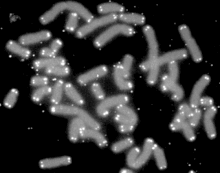telomere
Appearance
See also: télomère
English
[edit]
Etymology
[edit]From telo- (“end”) + -mere (“part”).
Pronunciation
[edit]IPA(key): /ˈtɛləmɪəɹ/, /ˈtiːləmɪəɹ/
Noun
[edit]telomere (plural telomeres)
- (genetics) Either of the sequences of DNA at each end of a eukaryotic chromosome.
- 2004, Peter M. Lansdorp, 11: Telomeres and Telomere Regulation, Robert Paul Lanza (editor), Handbook of Stem Cells, Volume 2: Adult and Fetal Stem Cells, page 127,
- Chromosome ends or telomeres are composed of guanine-rich repeat sequences and associated proteins. A minimum number of repeats is essential for proper telomere function and to avoid sustained activation of DNA damage pathways that may result in replicative senescence or cell death.
- 2005, Cara Birrittieri, What Every Woman Should Know about Fertility and Her Biological Clock[1], page 51:
- It has been known for some time that when cells divide, causing chromosomes to duplicate, telomeres get shorter. The more a cell divides, then, the shorter the telomeres become.
- 2007, Peter Sutovsky, Somatic Cell Nuclear Transfer[2], page 78:
- Previous studies have examined telomere lengths as an indirect measure of aging in cloned animals. Sheep were reported to have shorter telomeres suggestive of premature aging while cattle had either age-appropriate or longer telomeres.
- 2004, Peter M. Lansdorp, 11: Telomeres and Telomere Regulation, Robert Paul Lanza (editor), Handbook of Stem Cells, Volume 2: Adult and Fetal Stem Cells, page 127,
Related terms
[edit]Translations
[edit]either of the sequences of DNA at each end of a eukaryotic chromosome
|

